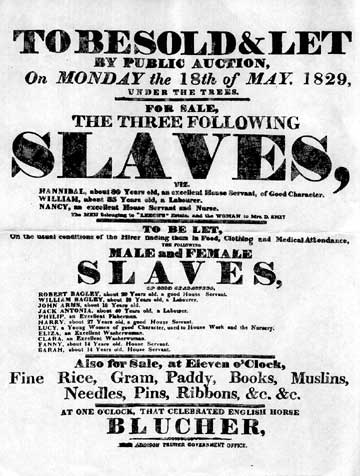|
 Indentured
servants Indentured
servants
by June Payne Flath
It was an opportunity.
It was slavery. Some believe indentured servitude provided
passage to the New World. It’s been referred to as white
slavery as well as simply a business opportunity. Whether
it was a form of welfare or a chance to pay off debt depends
on the situation and whom you ask.
In the beginning, settlement of British
North America was not the goal. Early traders had a lucrative
business going with the natives and there was concern that
settlers might interfere. In time though Britain came to realize
the best way to protect this piece of prime real estate was
to populate it. That proved easier said than done. It was
costly to cross the Atlantic, and those who could afford passage
were not really the class of people needed.
Strong men were needed willing to swing
an axe all day, consider oxen their best friends and survive
winters on little food. Women who would tolerate such men,
not be opposed to swinging an axe and befriending oxen, would
also be welcome.
Farmers, blacksmiths, and innkeepers all
needed apprentices, people that would learn their skills and
carry them on. At the same time England, Ireland and Scotland
had swarms of unemployed due to the Industrial Revolution.
Their streets, poor houses, orphanages and prisons were overflowing
with homeless people. What to do with them was an ongoing
debate. Shipping them to the colonies was a solution for both
sides of the ocean.
Indentured labour was a form of contract
employment usually with a three- to seven-year time frame.
A person became an indentured servant by agreeing to work
off a debt during a specified term. “Debt slaves”
is another phrase to describe the arrangement, especially
in the case of prisoners and youth who had no choice and no
other opportunity to repay the debt.
Supporting a family was not only difficult
in the United Kingdom, it remained a challenge in the New
World. Since Ontario did not have “Poor Laws” (legal
obligation for municipalities to care for the local poor)
couples with a large number of offspring might make arrangements
for a child to be indentured.
A farmer unable to provide farms for all
his children might arrange to have one or more of them indentured
to a large local land owner. The agreement might include land
for a young man who worked to the completion of his term,
or domestic service for a daughter.
One estimate claims half of the white
settlers of North America were indentured servants. Destitute,
they agreed to work for the purchaser of the indenture upon
arrival in this foreign land. Jim Struthers, chairman of the
Canadian Studies Department at Trent University, says that
employers in Upper Canada used indentured servitude as a means
of maintaining a labour force. It was a legal contract that
held people to a particular employment, to a place, at least
long enough to pay back the initial cost of the passage. Some
contracts were similar to apprenticeships while the terms
of others were harsh. Some felt indentured servants were treated
worse than slaves. They only needed to keep the worker alive
for the term of the contract; if they died shortly after,
it was not their loss. Contracts varied from situation to
situation with no standard form. Permanent employment, a learned
skill, the promise of land, tools, any and all of these might
be promised for those who stayed for the duration of their
contract.
While women were in great demand in Upper
Canada, the only category open to a single woman who wished
to travel to Canada was domestic servant. Jane Ralston arrived
in Upper Canada in the 1850s at the age of sixteen. As the
daughter of parents too poor to care for her in a village
that offered no employment opportunities, she had been indentured
to a master in St. Thomas. Unhappy with her treatment in his
household, she ran away. Fugitive notices for runaway “white
slaves” were not uncommon; however, Europeans did not
stand out in a crowd, as did African slaves, and it was easy
for them to simply disappear. Jane made her way to Niagara
Falls and married Samuel Hall, a black fugitive slave from
the American south. Together they operated a hotel in the
Niagara Falls district and provided carriage transportation
for tourists.
“It was a way to provide for children,”
says Larry Hall, descendant of Samuel and Jane. He says while
they know little of how arrangements were made, they do know
that both Jane’s family and her master’s family
in St. Thomas had originated from the same village in Scotland.
“It was a widely used device in Great
Britain. They had a number of ways for getting rid of surplus.”
Eventually Upper Canada’s population
grew and businesses expanded, creating job opportunities,
reducing the need for indenture to ensure a work force. People
came as indentured servants, they stayed and their stories
are woven into the fabric of our history, our legends, our
lives.
This is an original story,
first published in The Country Connection Magazine,
Issue 50, Summer 2005. Copyright June Payne Flath.
RETURN
TO STORY INDEX
RETURN
TO BACK ISSUE PAGE
|

